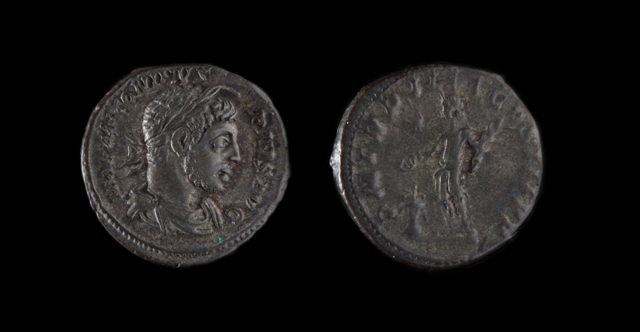Elagabalus, Silver Denarius
Dublin Core
Title
Elagabalus, Silver Denarius
Subject
Elagabalus, Silver Denarius. 221 CE.
OBVERSE: IMP ANTONINVS PIVS AVG (Imperator Antoninus Pius Augustus), laureate, draped and cuirassed bust right, also crowed with horn.
REVERSE: PM TR P IIII COS III PP (Pontifex Maximus, tribunician power for the 4th time, Consul for the 3rd time, pater patriae). Emperor standing left, sacrificing over altar with patera and branch, star to left.
OBVERSE: IMP ANTONINVS PIVS AVG (Imperator Antoninus Pius Augustus), laureate, draped and cuirassed bust right, also crowed with horn.
REVERSE: PM TR P IIII COS III PP (Pontifex Maximus, tribunician power for the 4th time, Consul for the 3rd time, pater patriae). Emperor standing left, sacrificing over altar with patera and branch, star to left.
Description
Elagabalus, also known as Heliogabalus, was the leader of the Roman Empire from 218-222 CE. Caracalla, who was Elagabalus’ cousin, was assassinated by the praefect of the Praetorian Guard, Marcus Opellius Macrinus, in 217 CE. Macrinus replaced Caracalla as emperor but was ousted within a year through the scheming of the rightful imperial family. Cassius Dio (Hist. 79.30-34) reports that Elagabalus’ grandmother, Julia Maesa (who was the sister of Septimius Severus’ wife, Julia Domna), helped him come to power by passing him off as the illegitimate son of Caracalla and by bribing troops to support him. Elagabalus was a mere 14 years old when he took the throne.
Elagabalus is remembered for his decadence and disregard for Roman tradition. He not only replaced Zeus, the head of the Roman Pantheon, with Elagabal (and in the process making himself the ‘most elevated priest’), but also married a Vestal Virgin, the sacred priestesses of the city of Rome whose chastity is considered essential for the continued safety of the city. He was assassinated at the young age of 18, in 222 CE, and replaced with Julia Maesa’s other grandson, Severus Alexander.
The obverse of the coin notes that they emperor is crowned with a horn. This is not a typo, a horn was a long standing tradition of divinity in Eastern religions – the same ones Elagabalus was associated with.
Elagabalus is remembered for his decadence and disregard for Roman tradition. He not only replaced Zeus, the head of the Roman Pantheon, with Elagabal (and in the process making himself the ‘most elevated priest’), but also married a Vestal Virgin, the sacred priestesses of the city of Rome whose chastity is considered essential for the continued safety of the city. He was assassinated at the young age of 18, in 222 CE, and replaced with Julia Maesa’s other grandson, Severus Alexander.
The obverse of the coin notes that they emperor is crowned with a horn. This is not a typo, a horn was a long standing tradition of divinity in Eastern religions – the same ones Elagabalus was associated with.
Source
Gift of James and Aneta McIntyre, Hallie Ford Museum of Art, Salem, OR. 2006.010.044
Date
221 CE
Rights
Hallie Ford Museum of Arts
Format
0.736 in
0.120 oz
0.120 oz
Language
Latin
Type
Coin
Coverage
This item can be viewed on Hallie Ford Museum of Art's website.
Citation
“Elagabalus, Silver Denarius,” Hallie Ford Museum of Art Exhibits, accessed December 30, 2025, https://library.willamette.edu/hfma/omeka/items/show/95.
